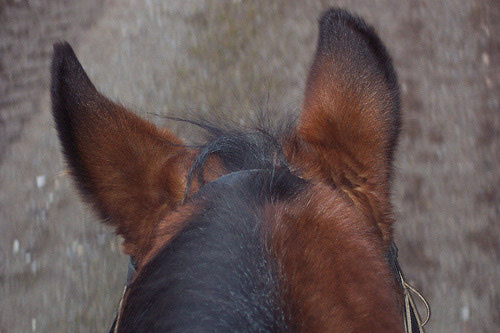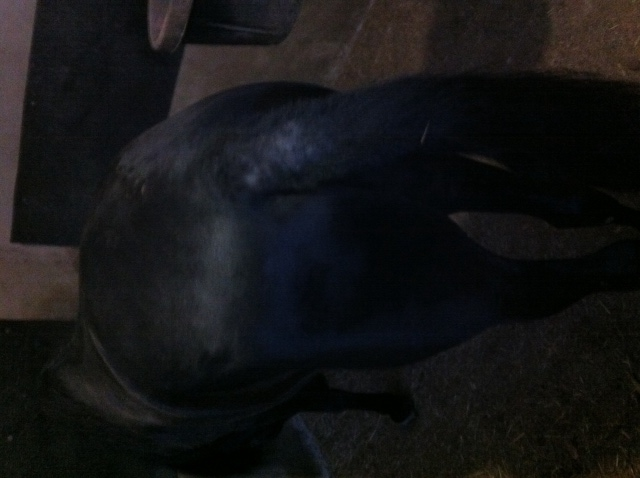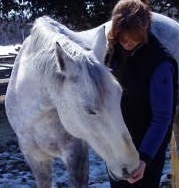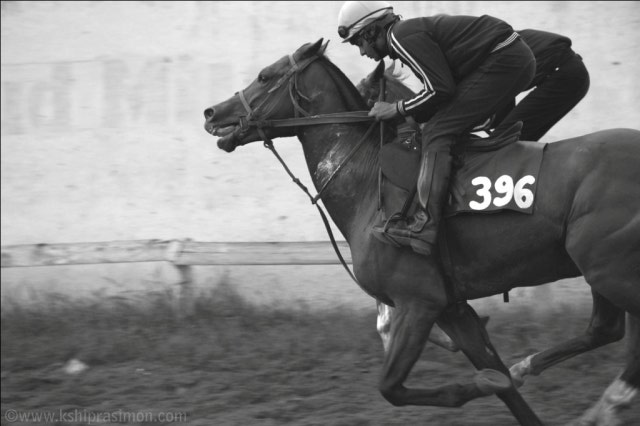QuestionQUESTION: I have a twelve year old fox trotter gelding and he has many bad habits that i can't seem to break. First when you try to get on him he starts to walk away as soon as you put the rains over his head, he also will not turn very well and tends to try and walk sideways trying to get to were he wants to go. Most of the time you cannot get him away from his pasture buddy without him going crazy. When i put him on a lead rope he will not walk beside me or behind me, instead he head buts me and tries to get in front of me. He also doesn't like to stop at anytime, whether he is on a lead rope or im ridding him. He also likes to paw at the ground when im leading him which has caused him to break two of my toes twice. he also likes to paw at the ground when i am ridding him too. But he doesn't like to be rode without other horses around.And he also tends to be very jumpy, you cannot move your hand around his face or move a rope to fast around him or he will run away. Do you have any suggestion to help me fix these problems? if so i would truly appreciate your help.
ANSWER: Hello Brittany,
There are many concerns that you have to deal with. First of all, realize that your horse is not being difficult "on purpose"-he just does not know any better. You do not mention how long you have had him or where he came from, but he has either had improper handling or just not focused
training that allowed him to understand what he is SUPPOSED to be doing.
There are many good books to read that will help you...Anthony Crosley has one...."The First Four Years",...and Linda Tellington Jones method of T.E.A.M. would prove useful. My web site, www.MitziSummers.com, has some articles that may help.
You have to start from the beginning with him...retraining, and start with ground work.The first thing you need to do is to teach him correct leading and go on from there. Using the wand that T.E.A.M. advocates,(as an extension of your arm), will help when you are leading him. I would also teach him to longe, and some quiet, focused light round pen work...NOT chasing him around,will help both of you to relate to each other. You will need to really read and research, and be careful. There are so many marketing techniques out there, and some are not tailored to the horse as an individual.
When you do mount him, I have always found the easiest way is at first to just lead him up to the mounting block, offer him a treat, and lead him away. Do it again when he stands for a bit, then finally when he stands for mounting.Then you only need to do this every once in a while. I have seen "natuaral" techniques that incorporate chasing the horse around the block.....I do not think that this makes any sense to most horses. You want to train your horse in the clearest and kindest way possible.
My email is Summersdressage@aol.com. I would like to know more about your skills and experience so I can help you more. Many times in riding we confuse our horses, as our aids are not clear to them.
You need also to desensitize your horse. You need to do this training away from other horses. As he learns to trust you and understand what you want him to do, ,he will be more confident in leaving his herd. Remember that a horse is a prey animal and his herd represents safety to him. I really think you should look for an experienced, intelligent, thoughtful professional horse trainer to help you, but this can be difficult. I admit I have much to learn, but 90 per cent of my business is in helping people retrain their horses that a "professional" has not been successful with. The firat thing is to make certain that they are thoughtful, consider the horse as an individual, sentient being, and that whatever they are advocating makes sense to you and the horse. If it looks like it is cruel or forced, it probably is.
I will be glad to help you with more specific answers to each problem as it comes up. You could write to EXPERTS again. Just be sure to first start with ground work, leading and longeing. If your Fox Trotter is gaited you have to be really careful with any round penning or longeing as small circles are difficult for him. Also, be certain that you are using your hands and body correctly when turning him when you are riding. An excellent book for you also to read is CENTERED RIDING by Sally Swift.
---------- FOLLOW-UP ----------
QUESTION: I have been ridding horses for about ten years, i have had one other gaited horses before this one that was a paso fino. but this is the only horse i have had that im not able to teach it to do what i want him to do. My fox trotter i have now is supposed to be broke to were u can either turn him by turning yourself in the saddle in the direction you want to go or by you barely having to pull on the reins. However, he will not do either.... Do you have any suggestions of what i can do to stop my horse from pawing at me and the ground? Thank you for all the tips and information i really appreciate it.
Answer Remember from my original answer that your horse does not know what he is supposed to do so it is training and retraining that is needed.You have to approach him with the outlook that he just does not understand what people told you that he knew.
However, I do think that you should try to enlist the help of a good riding instructor/trainer to help you. This can be difficult. You need to be certain that YOUR signals and your riding technique is correct. Every horse is an individual, and this horse obviously responds differently than your Paso Fino.
I just had a student that was having troube turning her horse because she was not using her aids correctly. For a right turn, start from your center.....just below your naval. Turn and look from your "belt buckle" in the direction that you want your horse to go. If you are turning to the right, your right leg will be at the girth,and your outside leg behind the girth.
If you are riding with two reins (only with a side pull, Bitless Bridle, or a snaffle, then the right rein is a direct rein and the outside rein is a supporting rein. Do not cross the outside rein over the crest unless the horse knows how to neck rein and you are intending to neck rein.
If your horse does not turn, it is your OUTSIDE aids, i.e. outside leg that will help you. If you get the horse too crooked, the head and neck too much to one side, it will be easy for the horse to move sideways AWAY from the direction you want it to go.
The pawing may well be because your horse is impatient or anxious.Do not yell at him or strike him (I know you are not), because that will only make him more fearful or anxious. Give him something to do, turn him, walk and halt him. Speak soothingly to him. I use a TEAM wand to stroke him (a long dressage whip will do), NOT to hit him, but just stroke him in long waves. This is better than your hand once you get him accustomed to it, as you are at a further distance from him. Did you check the article on my blog or website www.mitzisummers.com, to see if they would help?
What type of bit do you have in his mouth? Horses will run AWAY from pain. if you try a Bitless Bridle or a different bit, do so only with the help of a good professional and in an enclosed area .A horse should stop more from your seat than pulling on his mouth. Start from the ground reteaching him the aids to slow and halt. This can be dangerous, so it is IMPORTANT that you enlist help from an experienced horseperson.

 concentrate on ears
Question
horse ears
hello sir, while trotting a
concentrate on ears
Question
horse ears
hello sir, while trotting a
 Hair loss
Question
Tail Tail close up
Rick: i have r
Hair loss
Question
Tail Tail close up
Rick: i have r
 putting halter on
Questionhi,
Im probably going to sound like an complet
putting halter on
Questionhi,
Im probably going to sound like an complet
 tongue up
Questiontongue up
QUESTION: hello maam, is this
tongue up
Questiontongue up
QUESTION: hello maam, is this
 trotting my horse on road
Question
road
hello. i am rohit from india. i ha
trotting my horse on road
Question
road
hello. i am rohit from india. i ha